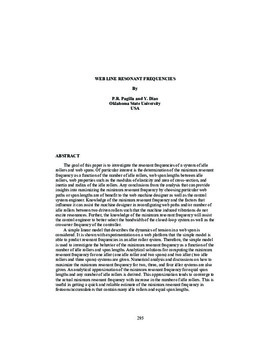| dc.contributor.author | Pagilla, P. R. | |
| dc.contributor.author | Diao, Y. | |
| dc.contributor.other | International Conference on Web Handling (2009) | |
| dc.date.accessioned | 2019-11-11T19:52:43Z | |
| dc.date.available | 2019-11-11T19:52:43Z | |
| dc.date.issued | 2009-06 | |
| dc.identifier | oksd_icwh_2009_pagilla | |
| dc.identifier.citation | Pagilla, P. R., & Diao, Y. (2009, June). Web line resonant frequencies. Paper presented at the Tenth International Conference on Web Handling (IWEB), Stillwater, OK. | |
| dc.identifier.uri | https://hdl.handle.net/11244/321953 | |
| dc.description.abstract | The goal of this paper is to investigate the resonant frequencies of a system of idle rollers and web spans. Of particular interest is the determination of the minimum resonant frequency as a function of the number of idle rollers, web span lengths between idle rollers, web properties such as the modulus of elasticity and area of cross-section, and inertia and radius of the idle rollers. Any conclusions from the analysis that can provide insights into maximizing the minimum resonant frequency by choosing particular web paths or span lengths are of benefit to the web machine designer as well as the control system engineer. Knowledge of the minimum resonant frequency and the factors that influence it can assist the machine designer in reconfiguring web paths and/or number of idle rollers between two driven rollers such that the machine induced vibrations do not excite resonances. Further, the knowledge of the minimum resonant frequency will assist the control engineer to better select the bandwidth of the closed-loop system as well as the crossover frequency of the controller. | |
| dc.description.abstract | A simple linear model that describes the dynamics of tension in a web span is considered. It is shown with experimentation on a web platform that the simple model is able to predict resonant frequencies in an idler roller system. Therefore, the simple model is used to investigate the behavior of the minimum resonant frequency as a function of the number of idle rollers and span lengths. Analytical solutions for computing the minimum resonant frequency for one idler (one idle roller and two spans) and two idler (two idle rollers and three spans) systems are given. Numerical analysis and discussions on how to maximize the minimum resonant frequency for two, three, and four idler systems are also given. An analytical approximation of the minimum resonant frequency for equal span lengths and any number of idle rollers is derived. This approximation tends to converge to the actual minimum resonant frequency with increase in the number of idle rollers. This is useful in getting a quick and reliable estimate of the minimum resonant frequency in festoons/accumulators that contain many idle rollers and equal span lengths. | |
| dc.format | application/pdf | |
| dc.language | en_US | |
| dc.publisher | Oklahoma State University | |
| dc.rights | In the Oklahoma State University Library's institutional repository this paper is made available through the open access principles and the terms of agreement/consent between the author(s) and the publisher. The permission policy on the use, reproduction or distribution of the article falls under fair use for educational, scholarship, and research purposes. Contact Digital Resources and Discovery Services at lib-dls@okstate.edu or 405-744-9161 for further information. | |
| dc.title | Web line resonant frequencies | |
| osu.filename | oksd_icwh_2009_pagilla.pdf | |
| dc.description.department | Mechanical and Aerospace Engineering | |
| dc.type.genre | Conference proceedings | |
| dc.type.material | Text | |
